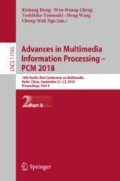Abstract
Cracked tongue can provide valuable diagnostic information for traditional Chinese Medicine doctors. However, due to similar model of real and fake tongue crack, cracked tongue recognition is still challenging. The existing methods make use of handcraft features to classify the cracked tongue which leads to inconstant performance when the length or width of crack is various. In this paper, we pay attention to localized cracked regions of the tongue instead of the whole tongue. We train the Alexnet by using cracked regions and non-cracked regions to extract deep feature of cracked region. At last, cracked tongue recognition is considered as a multiple instance learning problem, and we train a multiple-instance Support Vector Machine (SVM) to make the final decision. Experimental results demonstrate that the proposed method performs better than the method extracting handcraft features.
Access this chapter
Tax calculation will be finalised at checkout
Purchases are for personal use only
References
Nestler, G., Dovey, M.: Traditional Chinese medicine. Clin. Obstet. Gynecol. 44(4), 801–813 (2001)
Lao, L., Xu, L., Xu, S.: Traditional Chinese Medicine. pp. 125–135 (2012)
Zhang, H.Z., Wang, K.Q., Zhang, D., et al.: Computer aided tongue diagnosis system. In: 27th Annual International Conference of the Engineering in Medicine and Biology Society, IEEE-EMBS 2005, pp. 6754–6757. IEEE (2005)
Wang, X., Zhang, D.: A high quality color imaging system for computerized tongue image analysis. Expert Syst. Appl. 40(15), 5854–5866 (2013)
Cui, Q., Li, X., Li, J., Zhang, Y.: Geometric and tongue-mouth relation features for morphology analysis of tongue body. In: Chen, E., Gong, Y., Tie, Y. (eds.) PCM 2016. LNCS, vol. 9917, pp. 490–497. Springer, Cham (2016). https://doi.org/10.1007/978-3-319-48896-7_48
Liu, L.L., Zhang, D., Kumar, A., et al.: Tongue line extraction. In: 19th International Conference on Pattern Recognition, ICPR 2008, pp. 1–4. IEEE (2008)
Hittawe, M.M., Muddamsetty, S.M., Sidibé, D., et al.: Multiple features extraction for timber defects detection and classification using SVM. In: IEEE International Conference on Image Processing (ICIP), pp. 427–431. IEEE (2015)
Liu, L., Zhang, D., You, J.: Detecting wide lines using isotropic nonlinear filtering. IEEE Trans. Image Process. 16(6), 1584–1595 (2007)
Liu, L.L., Zhang, D.: Extracting tongue cracks using the wide line detector. In: Zhang, D. (ed.) ICMB 2008. LNCS, vol. 4901, pp. 49–56. Springer, Heidelberg (2007). https://doi.org/10.1007/978-3-540-77413-6_7
Hu, Y., Zhang, W., Lu, H., et al.: Wide line detection with water flow. In: 2016 IEEE International Conference on Bioinformatics and Biomedicine (BIBM), pp. 1353–1355. IEEE (2016)
Li, X., Wang, D., Cui, Q.: WLDF: effective statistical shape feature for cracked tongue recognition. J. Electr. Eng. Technol. 12(1), 420–427 (2017)
Krizhevsky, A., Sutskever, I., Hinton, G.E.: Imagenet classification with deep convolutional neural networks. In: Advances in Neural Information Processing Systems, pp. 1097–1105. (2012)
Andrews, S., Tsochantaridis, I., Hofmann, T.: Support vector machines for multiple-instance learning. In: Advances in Neural Information Processing Systems, pp. 577–584 (2003)
Doran, G., Ray, S.: A theoretical and empirical analysis of support vector machine methods for multiple-instance classification. Mach. Learn. 97(1–2), 79–102 (2014)
Author information
Authors and Affiliations
Corresponding author
Editor information
Editors and Affiliations
Rights and permissions
Copyright information
© 2018 Springer Nature Switzerland AG
About this paper
Cite this paper
Xue, Y., Li, X., Cui, Q., Wang, L., Wu, P. (2018). Cracked Tongue Recognition Based on Deep Features and Multiple-Instance SVM. In: Hong, R., Cheng, WH., Yamasaki, T., Wang, M., Ngo, CW. (eds) Advances in Multimedia Information Processing – PCM 2018. PCM 2018. Lecture Notes in Computer Science(), vol 11165. Springer, Cham. https://doi.org/10.1007/978-3-030-00767-6_59
Download citation
DOI: https://doi.org/10.1007/978-3-030-00767-6_59
Published:
Publisher Name: Springer, Cham
Print ISBN: 978-3-030-00766-9
Online ISBN: 978-3-030-00767-6
eBook Packages: Computer ScienceComputer Science (R0)

